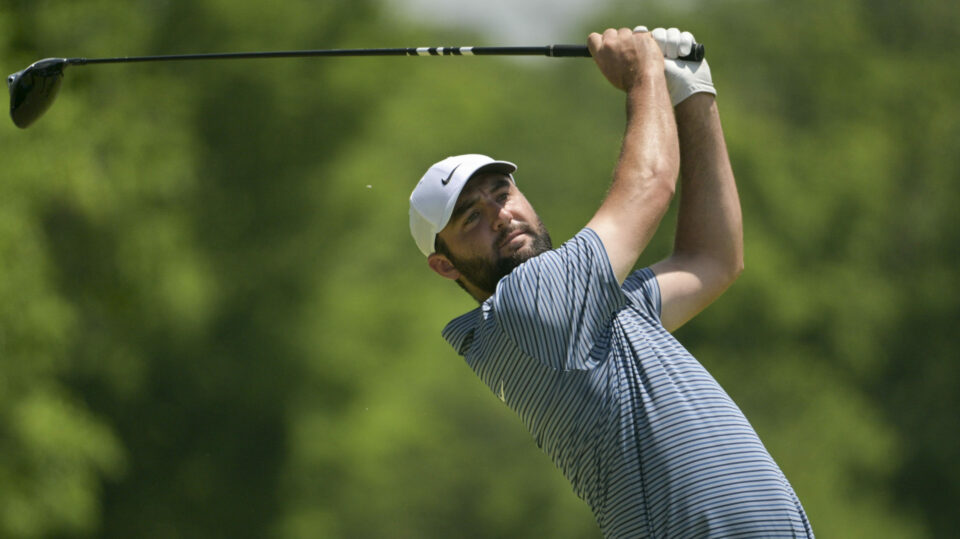Silver Medalists
12) The 15th / Par 5 / 550 yards (Firethorn)
2022 Stroke Average: 4.932 (15)
This is the final par five on the course and the one where players have to assess if a bold play is necessitated because of their standing in the tournament. The hole is famous for the Sarazen double-eagle but a range of scores have been made here over the years.
The hole has been considerably lengthened since the time of Sarazen when it played 485 yards. It has also been modified and presents a narrower driving area. With trees pushing in from the left and on the right, players attempt to drive their ball to the top of the hill and can then determine if going for the green over the frontal pond is worth the risk.
Major stroke swings can quickly happen. One of the most noted occurred in 1986 when a pursuing Jack Nicklaus eagled the hole and then moments later final round leader Seve Ballesteros bogied it after drowning his 4-iron approach into the pond. That three-shot swing helped propel Nicklaus into a proper contender and he made two additional birdies on his way to securing a record sixth Green Jacket.
No. 15, "Firethorn". 530 yds, par-5.
"It’s one of those holes I feel it’s key to lay up to a yardage you are comfortable to. If you have a yardage that is in between clubs, you’re going to have a tough time hitting the green.” - 2011 Masters champion @CA_Schwartzel pic.twitter.com/l4S5MyHzkU
— PGA TOUR (@PGATOUR) April 2, 2018
11) The 17th / Par 4 / 440 yards (Nandina)
2022 Stroke Average: 4.133 (10)
The penultimate hole was noted for many years as the hole with the Eisenhower tree. Named in honor of President Dwight D. Eisenhower – a long-time member of the club – the tree would often block his tee shots from the left side.
Co-founder Clifford Roberts dashed Eisenhower’s hopes of getting the tree cut down and it remained until February 2014 when a severe ice storm killed it.
The hole was lengthened by Tom Fazio in 2014 to its distance of 440 yards. The fairway is now well-protected by a sentinel of trees on both sides.
The green provides for a number of movements and it's crucial to land one's approach as near as possible to wherever the pin is located.
Key pin locations include the deep far left corner and also when placed in the far-right section that sits higher up on the green. Approach shots hit too long or missing the green to the corners face a daunting challenge in securing par.
No. 17, "Nandina". 440 yds, par-4.
"If you get a good drive away you might even have a wedge in your hand, so it is a hole that might not bring any fears but it is one you have to respect. If you add variables like weather and wind then the approach becomes tricky." - @JDayGolf pic.twitter.com/FnLPBnyB6M
— PGA TOUR (@PGATOUR) April 2, 2018
10) The 9th / Par 4 / 460 yards (Carolina Cherry)
2022 Stroke Average: 4.010 (13)
The final hole on the outward half works downhill and turns left before ascending to one of the steepest greens on the property. Working the ball from right-to-left pays dividends as the rollout takes golf balls to the bottom of the hill leaving a short iron to the green.
The approach must be properly executed. Players often will hit past the hole location and use the slope to feed the ball to the hole. Approach shots that land on the front can easily spin off the green and the closely mown grass will easily pull the ball upwards of 30-40 yards back down the fairway.
Side-hill putts can also be a test of nerve as major swings in both directions are possible. When green speeds are at an optimal level it is necessary for the player to be ever vigilant in preventing a sloppy three-putt to conclude the front nine.
No. 9, "Carolina Cherry". 460 yds, par-4.
"It’s a tee shot that looks fairly daunting. The second shot is on a severe downhill lie hitting severely uphill...hitting it to the middle of the green is pretty good." - 2007 Masters champion @ZachJohnsonPGA pic.twitter.com/M37zb2o67Z
— PGA TOUR (@PGATOUR) April 2, 2018
9) The 3rd / Par 4 / 350 yards (Flowering Peach)
2022 Stroke Average: 4.053 (11)
The only two-shot hole at Augusta that plays less than 400 yards, the third invites a bold play. When forward teeing areas are used the temptation to drive the green can be an offer too good to pass up. The downside is that actually keeping a ball on the small tilted green is no small feat.
Proper positioning off the tee pays dividends. Even with a wedge in hand the need for pinpoint accuracy is magnified because of the contours of the green. This becomes particularly acute when the pin position is in the far-left corner. When located there the amount of available landing space becomes a real challenge to attain.
No. 3, "Flowering Peach". 350 yds, par-4.
"You decide what you want to do according to where the pin placement is...It's one of the easier holes on the course. It's one of the holes you're looking at birdie." - 2011 Masters champion @CA_Schwartzel pic.twitter.com/tjOxt8Qtzh
— PGA TOUR (@PGATOUR) April 2, 2018
8) The 5th / Par 4 / 495 yards (Magnolia)
2022 Stroke Average: 4.332 (3)
The fifth traditionally receives less attention because of its position on the front nine and the fact the hole is somewhat sheltered away from the rest of the course.
For many years the hole played 450 yards and the fairway bunker on the left was more for directional purposes than anything else.
In 2011 architect Tom Fazio provided a major overhaul. The tee was pushed back five yards and the two fairway bunkers were re-positioned further down the fairway requiring a carry of 315. The width of the landing area by those bunkers was also narrowed.
Eight years later Augusta National was able to purchase a portion of the nearby Berckman's Road and have it re-routed so it could be extended even further and the carry over the left bunker has also increased.
Adding to the rigors of the hole is the devilish putting surface reshaped by architect Perry Maxwell in 1937.
Prior to the most recent changes players were able to simply hit three-metal from the tee followed by a mid-iron or less to the green. The added length has now brought back the challenge in mandating driver usage now with far more club for the approach shot.
First (At Least, Graphically Depicted) Look At Augusta National's Extended 5th Hole https://t.co/V7XGas7apm pic.twitter.com/8xnKVKYfT1
— Geoff Shackelford (@GeoffShac) January 31, 2019
7) The 4th / Par 3 / 240 yards (Flowering Crab Apple)
2022 Stroke Average: 3.258 (5)
This super-demanding long par three gets little real attention from everyone except for the players. The demands are plentiful – it was tied with the 11th for the least number of birdies in 2022.
Winds can swirl when standing on the tee, making club selection precarious. Carrying the front bunker is a must but any shot that fails to have sufficient loft can easily go off the back of the green. When the pin is cut in the front of the elbow section, it can be a real challenge to a player's ability to be accurate. The secret at the fourth is secure par and move on.
No. 4, "Flowering Crab Apple". 240 yds, par-3.
"It's probably the toughest hole on the golf course, to be honest. I'm just trying to get it on the green. It's just one of those holes where you're trying to make par. I think I made birdie once." - @JasonDufner pic.twitter.com/p9IBKJ6d28
— PGA TOUR (@PGATOUR) April 2, 2018
Part 1, Part 3



